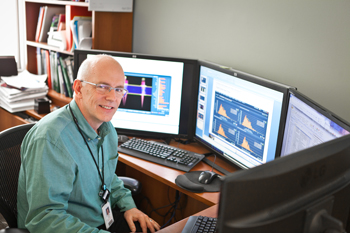Radiologists using natural language processing for better search results

By Kelly O’Brien

Dr. Bruce Gray is part of a team of radiologists using natural language processing to refine searches of the hospital’s radiology information system. (Photo by Yuri Markarov)
If a radiologist wanted to know how many patients at a hospital experienced claustrophobia in an MRI, but who had written on a questionnaire that they weren’t claustrophobic, it would be an extremely time-consuming process.
Radiologists don’t use templates or follow specific structures when dictating reports. Because every report is different, using standard software to search a hospital’s radiology information system may not turn up everything they’re looking for.
“Standard searches can find where the radiologist had dictated, ‘Exam stopped because of claustrophobia,’ but if one doctor doesn’t use the word ‘claustrophobia,’ they won’t have a complete list,” said Kate MacGregor, the quality improvement and radiation protection manager in the Medical Imaging Department at St. Michael’s Hospital.
MacGregor and her colleagues are improving the quality of their searches by incorporating natural language processing, a branch of computer science concerned with the interactions between computer and human languages.
Natural language processing allows search tools such as Montage, the software used at St. Michael’s, to understand human speech as it occurs naturally, both spoken and written, which allows for more accurate search results.
In the past, gathering this information could have been done only by chart review, said MacGregor.
Now, she said, radiologists have the tools to mine all the data in electronic medical records and the radiology information system, which houses all the reports.
Did you know? Natural language processing is a branch of computer science concerned with the interactions between computers and human languages. |
Adding natural language processing to a software, like Montage, isn’t as simple as flicking a switch, however.
“Let’s say 1,000 reports have what you want, that’s where the natural language processing piece comes in,” said Dr. Bruce Gray, a radiologist in St. Michael’s Medical Imaging Department. “We work with a statistics analysis software programmer to create algorithms that parse out the data or text, then we work to determine whether the results are useful.”
SAS programmers are needed to account for differences in the terminology radiologists use when dictating a report, according to MacGregor.
Until they can find enough examples, she said, the process is focused on getting to the sensitivity and specificity of the code itself.
“How often does it actually pull out what we’re looking for, versus finding something else?” she said. “Once we’ve validated that that string of code picks out 99.9 per cent of what we’re looking for, then we consider it done and we go on to the next one and start working on the next iteration.”
Once they’re able to categorize a particular report, said Dr. Gray, the radiologists can then use the report to develop and evaluate quality improvement initiatives, such as a clinical decision support tool radiology is developing with St. Michael’s Family Health Team to reduce unnecessary imaging tests.
“Natural language processing is a way of creating and validating these other tools, like the clinical decision support tool, and making sure our quality improvement projects deliver,” said Dr. Gray.
About St. Michael’s Hospital
St. Michael’s Hospital provides compassionate care to all who enter its doors. The hospital also provides outstanding medical education to future health care professionals in more than 29 academic disciplines. Critical care and trauma, heart disease, neurosurgery, diabetes, cancer care, and care of the homeless are among the Hospital’s recognized areas of expertise. Through the Keenan Research Centre and the Li Ka Shing International Healthcare Education Center, which make up the Li Ka Shing Knowledge Institute, research and education at St. Michael’s Hospital are recognized and make an impact around the world. Founded in 1892, the hospital is fully affiliated with the University of Toronto.
